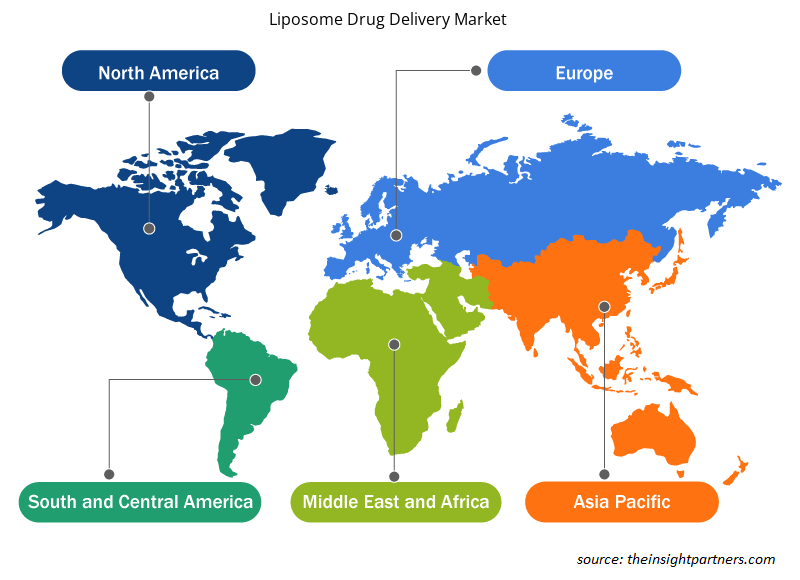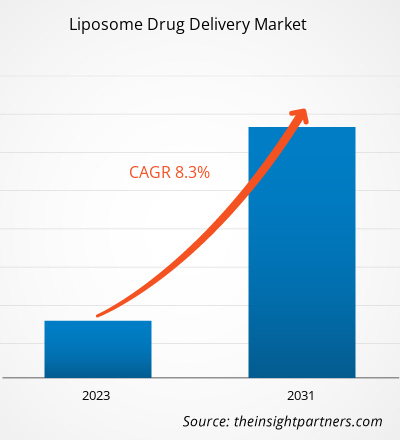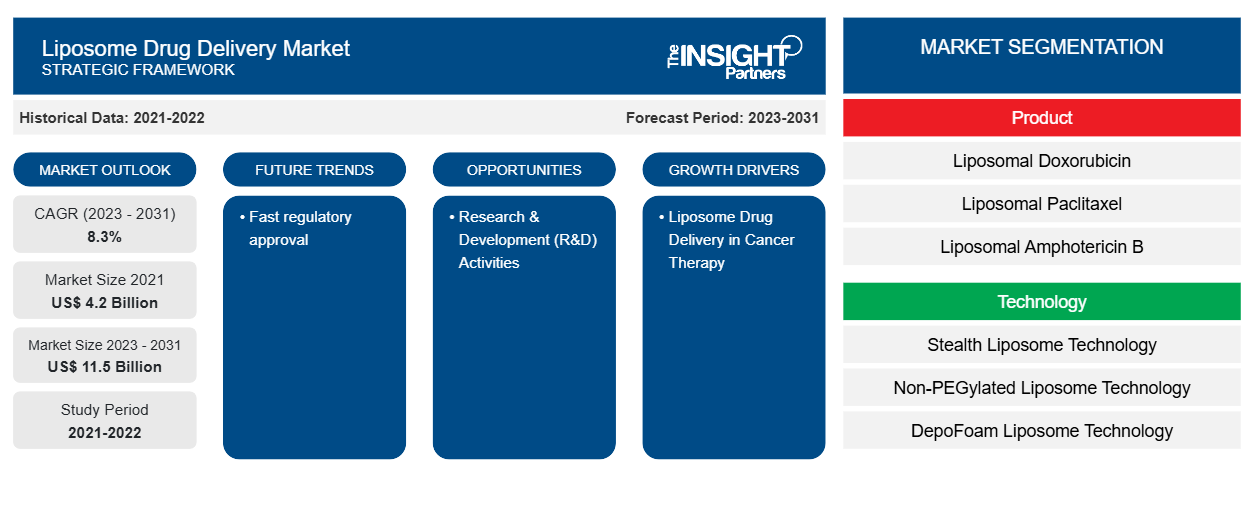Il mercato della somministrazione di farmaci tramite liposomi è stato valutato a 4,2 miliardi di dollari nel 2021 e si prevede che raggiungerà gli 11,5 miliardi di dollari entro il 2031. Si prevede che il mercato registrerà un CAGR dell'8,3% dal 2023 al 2031. È probabile che la rapida approvazione normativa rimanga una tendenza chiave del mercato della somministrazione di farmaci tramite liposomi.
Analisi di mercato per la somministrazione di farmaci tramite liposomi
Somministrazione di farmaci liposomiali nella terapia del cancro
I liposomi hanno rivoluzionato la terapia del cancro grazie alle loro ampie applicazioni. Ad esempio, i liposomi sono stati il primo sistema di somministrazione di farmaci basato sulla nanotecnologia approvato per applicazioni cliniche grazie alle loro caratteristiche di biocompatibilità e biodegradabilità. Inoltre, i liposomi si sono affermati nei sistemi di somministrazione di farmaci basati su nanocarrier per applicazioni cliniche di successo della formulazione liposomiale per la terapia antitumorale . Inoltre, i farmaci liposomiali hanno elevate proprietà di incapsulamento, mostrando una significativa attività antitumorale riducendo la tossicità e, in particolare, la cardiotossicità. Tale tecnica di incapsulamento del trattamento liposomiale (incapsulamento) mostra una grande circolazione prolungata simile a "Daunorubicina" e "Doxorubicina liposomiale pegilata". I fattori sopra menzionati sono responsabili dell'influente crescita del mercato della somministrazione di farmaci liposomiali durante il 2021-2031.
Panoramica del mercato della somministrazione di farmaci tramite liposomi
Tecnologia, innovazione e soluzioni tecnologiche intelligenti come la somministrazione di farmaci liposomiali continuano a influenzare in modo significativo la somministrazione di farmaci liposomiali. La somministrazione di farmaci liposomiali nella terapia del cancro e i lanci di prodotti efficienti per la somministrazione di farmaci liposomiali sono i fattori più influenti responsabili della crescita del mercato della somministrazione di farmaci liposomiali. La rapida approvazione normativa è una tendenza chiave per la crescita del mercato della somministrazione di farmaci liposomiali. Le attività di ricerca e sviluppo (R&S) forniranno opportunità di mercato redditizie.
Personalizza questo report in base alle tue esigenze
Riceverai la personalizzazione gratuita di qualsiasi report, comprese parti di questo report, o analisi a livello nazionale, pacchetto dati Excel, oltre a usufruire di grandi offerte e sconti per start-up e università
-
Scopri le principali tendenze di mercato in questo rapporto.Questo campione GRATUITO includerà analisi di dati che spaziano dalle tendenze di mercato alle stime e alle previsioni.
Somministrazione di farmaci tramite liposomiFattori di mercato e opportunità
Lanci di prodotti efficienti per la somministrazione di farmaci tramite liposomi per favorire il mercato
- Nell'ottobre 2021, Evonik ha annunciato il lancio del "LIPEX EXTRUDER" di nuova generazione per una produzione rapida ed efficace di farmaci liposomiali. LIPEX offre un'elevata produttività e tempi di produzione in lotti più rapidi per le formulazioni di somministrazione di farmaci liposomiali.
- A gennaio 2022, Pfizer e Acuitas Therapeutics hanno annunciato una collaborazione strategica per la "Lipid Nanoparticle (LNP) Technology" di Acuita per un potenziale utilizzo. La tecnologia è promettente sia per lo sviluppo di vaccini che di terapie, concentrandosi sull'impegno di Pfizer per soluzioni innovative e pagando la strada per nuovi progressi nel campo.Acuitas Therapeutics announced a strategic collaboration for Acuita's "Lipid Nanoparticle (LNP) Technology" for potential utilization. The technology holds promise for both vaccine and therapeutic development, focussing on Pfizer's commitment to innovative solutions and paying the way for novel advancements in the field.
Pertanto, il lancio efficiente dei prodotti e la collaborazione strategica per la somministrazione di farmaci tramite liposomi contribuiranno in modo significativo nei prossimi anni.
Attività di ricerca e sviluppo (R&S) per il mercato della somministrazione di farmaci tramite liposomi: un'opportunità
I principali produttori che sviluppano la somministrazione di farmaci tramite liposomi stanno capitalizzando l'attenzione sulle attività di R&S per lo sviluppo di nanomateriali, nanosfere, liposomi e nanoparticelle. Tale somministrazione di farmaci tramite liposomi può sfruttare le attività farmacologiche in vivo e in vitro per le pratiche cliniche di routine. Dalla scoperta dei liposomi di prima generazione, le nanoparticelle lipidiche (LNP) si sono evolute enormemente con un'elevata adozione nell'industria farmaceutica. Ad esempio, i liposomi stimoli-responsivi sono un altro approccio attualmente in fase di studio che migliora la somministrazione di farmaci nei tumori, mentre sono progettati per essere rilasciati sotto determinati stimoli fisico-chimici o biochimici. Esempi includono "Doxorubicina", "5-fluorouracile" e "AMD3100". Inoltre, la ricerca futura coinvolge una serie di studi clinici di fase 1/2 che attualmente studiano la formulazione di LNP come bersaglio dell'immunoterapia del cancro per tumori solidi, tra cui melanoma, glioblastoma adulto, cancro gastrointestinale e cancro genitourinario, concentrandosi su un ampio uso clinico. Pertanto, le attività di ricerca e sviluppo offrono opportunità di mercato redditizie, che rappresenteranno una quota di mercato considerevole nei prossimi anni per il mercato della somministrazione di farmaci tramite liposomi.
Somministrazione di farmaci tramite liposomi
Analisi della segmentazione del rapporto di mercato
I segmenti chiave che hanno contribuito alla derivazione dell'analisi di mercato della somministrazione di farmaci tramite liposomi sono candidature e servizi.
- In base al prodotto, il mercato della somministrazione di farmaci liposomici è segmentato in doxorubicina liposomiale, paclitaxel liposomiale, amfotericina b liposomiale e altri. La doxorubicina liposomiale potrebbe detenere una quota di mercato maggiore nel 2023.
- In base alla tecnologia, il mercato del rilascio di farmaci tramite liposomi è segmentato in tecnologia dei liposomi stealth, tecnologia dei liposomi non pegilati, tecnologia dei liposomi depofoam, liposomi lisolipidi termosensibili. La tecnologia dei liposomi stealth potrebbe detenere una quota di mercato maggiore nel 2023.
- In base all'applicazione, il mercato del rilascio di farmaci liposomici è segmentato in malattie fungine, terapia del cancro, gestione del dolore, vaccini virali e terapia fotodinamica. La terapia del cancro potrebbe detenere una quota di mercato maggiore nel 2023.
Analisi della quota di mercato della somministrazione di farmaci tramite liposomi per area geografica
L'ambito geografico del rapporto Liposomy Drug Delivery Market è suddiviso principalmente in cinque regioni: Nord America, Asia Pacifico, Europa, Medio Oriente e Africa e Sud America/Sud e Centro America.
Il Nord America ha dominato il mercato della somministrazione di farmaci liposomici. In Nord America, gli Stati Uniti rappresentano una quota considerevole per la somministrazione di farmaci liposomici. Presenza dei principali attori della biotecnologia medica e biofarmaceutica negli Stati Uniti. Inoltre, la presenza di Contract Research Organization (CRO) è uno dei fattori più influenti responsabili della crescita del mercato. Si prevede che l'Asia Pacifica crescerà con il CAGR più elevato nei prossimi anni.
Somministrazione di farmaci tramite liposomi
Approfondimenti regionali sul mercato della somministrazione di farmaci tramite liposomi
Le tendenze regionali e i fattori che influenzano il mercato del rilascio di farmaci liposomici durante il periodo di previsione sono stati ampiamente spiegati dagli analisti di Insight Partners. Questa sezione discute anche i segmenti e la geografia del mercato del rilascio di farmaci liposomici in Nord America, Europa, Asia Pacifico, Medio Oriente e Africa e America meridionale e centrale.

- Ottieni i dati specifici regionali per il mercato della somministrazione di farmaci liposomiali
Ambito del rapporto di mercato sulla somministrazione di farmaci tramite liposomi
| Attributo del report | Dettagli |
|---|---|
| Dimensioni del mercato nel 2021 | 4,2 miliardi di dollari USA |
| Dimensioni del mercato entro il 2031 | 11,5 miliardi di dollari USA |
| CAGR globale (2023-2031) | 8,3% |
| Dati storici | 2021-2022 |
| Periodo di previsione | 2023-2031 |
| Segmenti coperti |
Per Prodotto
|
| Regioni e Paesi coperti |
America del Nord
|
| Leader di mercato e profili aziendali chiave |
|
Densità degli attori del mercato della somministrazione di farmaci tramite liposomi: comprendere il suo impatto sulle dinamiche aziendali
Il mercato del Liposoma Drug Delivery Market sta crescendo rapidamente, spinto dalla crescente domanda degli utenti finali dovuta a fattori quali l'evoluzione delle preferenze dei consumatori, i progressi tecnologici e una maggiore consapevolezza dei benefici del prodotto. Con l'aumento della domanda, le aziende stanno ampliando le loro offerte, innovando per soddisfare le esigenze dei consumatori e capitalizzando sulle tendenze emergenti, il che alimenta ulteriormente la crescita del mercato.
La densità degli operatori di mercato si riferisce alla distribuzione di aziende o società che operano in un particolare mercato o settore. Indica quanti concorrenti (operatori di mercato) sono presenti in un dato spazio di mercato in relazione alle sue dimensioni o al valore di mercato totale.
Le principali aziende che operano nel mercato della somministrazione di farmaci tramite liposomi sono:
- Società farmaceutica Takeda Limited,
- Novartis,
- Gruppo farmaceutico Luye,
- Ipsen Farmaceutica,
- CELSION, Inc.,
- Astellas Pharma, Inc.,
Disclaimer : le aziende elencate sopra non sono classificate secondo un ordine particolare.

- Ottieni una panoramica dei principali attori del mercato della somministrazione di farmaci tramite liposomi
Somministrazione di farmaci tramite liposomiNotizie di mercato e sviluppi recenti
Il mercato Liposome Drug Delivery viene valutato raccogliendo dati qualitativi e quantitativi dopo la ricerca primaria e secondaria, che include importanti pubblicazioni aziendali, dati di associazioni e database. Di seguito è riportato un elenco degli sviluppi nel mercato per Liposome Drug Delivery e strategie:
- A giugno 2022, la società sussidiaria di Endo Internal Plc "Endo Ventures Limited (EVL)" e Taiwan Liposome Company, Ltd. (TLC) hanno annunciato una collaborazione per commercializzare "TLC599", un prodotto sperimentale di TLC. Attualmente, TLC599 è un composto iniettabile progettato per affrontare il dolore al ginocchio causato dall'osteoartrite, che dimostra i continui sforzi per far progredire le opzioni di trattamento nell'area terapeutica.
Copertura del rapporto di mercato e risultati del rilascio di farmaci tramite liposomi
Il rapporto "Liposome Drug Delivery Market Size and Forecast (2021–2031)" fornisce un'analisi dettagliata del mercato che copre le seguenti aree:
- Dimensioni e previsioni del mercato a livello globale, regionale e nazionale per tutti i segmenti di mercato chiave coperti dall'ambito
- Dinamiche di mercato come fattori trainanti, vincoli e opportunità chiave
- Principali tendenze future
- Analisi dettagliata delle cinque forze PEST/Porter e SWOT
- Analisi di mercato globale e regionale che copre le principali tendenze di mercato, i principali attori, le normative e gli sviluppi recenti del mercato
- Analisi del panorama industriale e della concorrenza che copre la concentrazione del mercato, l'analisi della mappa di calore, i principali attori e gli sviluppi recenti
- Profili aziendali dettagliati
- Analisi storica (2 anni), anno base, previsione (7 anni) con CAGR
- Analisi PEST e SWOT
- Valore/volume delle dimensioni del mercato - Globale, Regionale, Nazionale
- Industria e panorama competitivo
- Set di dati Excel
Report recenti
Rapporti correlati
Testimonianze
Motivo dell'acquisto
- Processo decisionale informato
- Comprensione delle dinamiche di mercato
- Analisi competitiva
- Analisi dei clienti
- Previsioni di mercato
- Mitigazione del rischio
- Pianificazione strategica
- Giustificazione degli investimenti
- Identificazione dei mercati emergenti
- Miglioramento delle strategie di marketing
- Aumento dell'efficienza operativa
- Allineamento alle tendenze normative























 Ottieni un campione gratuito per - Mercato della somministrazione di farmaci tramite liposomi
Ottieni un campione gratuito per - Mercato della somministrazione di farmaci tramite liposomi